Scattering
Definitions
Problem:
A target of Aluminum (A = 27) with an aerial density of 1 mg/cm2
is positioned perpendicular to a 0.5 μA beam of deuterons (Z = 1). If the cross
section for producing protons at an angle of 30o with respect to the
beam direction is 15 mb/sr, (1 mb = 10-27 cm2), how many
protons per second will be incident on a 1 cm2 detector facing the
target at 30o and 10 cm from the target?
Solution:
- Concepts:
The cross section
- Reasoning:
We are given the cross section for producing a proton in a single deuteron -
Aluminum nucleus collision.
We are asked to find the total number of protons hitting a detector per
second.
- Details of the calculation:
If we have not one, but many scattering centers we distinguish the following
limiting cases:
(a) small beam, big target:
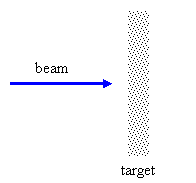
(# of particles scattered into the solid angle dΩ)/s
= [(# of beam particles)/s] * [(# of target particles)/area ] * σ(Ω)dΩ.
(b) big beam, small target:

(# of particles scattered into the solid angle dΩ)/s
= [(# of beam particles)/(area * s)] * (# of target particles) * σ(Ω)dΩ.
In this problem we have case (a).
(# of beam particles)/s = (0.5*10-6 C/s)/(1.6*10-19 C)
= 3.125*1012/s.
(# of aluminum atoms)/cm2 = (1 mg/cm2)/(27*1.6*10-27
kg) = 2.29*1019/cm2.
What is dΩ?
r2dΩ = (10 cm2)dΩ = 1 cm2, dΩ = 0.01 sr.
# of protons/s = (3.125*1012/s) * (2.29*1019/cm2)
* (15*10-27 cm2) * 0.01 = 1 * 104/s.
Hard sphere scattering
Problem:
Calculate the differential and total scattering cross section for scattering
a particle off a fixed, "hard" sphere of radius R.
Solution:
- Concepts:
The scattering cross section, scattering from a spherically
symmetric potential
- Reasoning:
The potential has spherical symmetry, V(r) = ∞, r < R;
V(r) = 0, r > R.
- Details of the calculation:
For scattering off a central potential we
have σ(θ) = |(b/sinθ)(db/dθ)|, θ = π - 2φ0.
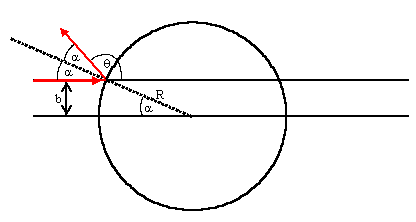
Referring to the
figure above we have
b/R = sinα
θ = π - 2α.
α = (π - θ)/2.
b =
Rsin(π/2 - θ/2) = Rcos(θ/2).
db/dθ = (R/2)sin(θ/2).
σ(θ) =
(b/sinθ)((R/2)sin(θ/2) = R2cos(θ/2)sin(θ/2)/(2sinθ) = R2/4.
σtotal = ∫σ(θ)dΩ, = ∫∫σ(θ)sin(θ)dθdΦ = πR2 = total
elastic scattering cross section.
Problem:
A steel disk A with radius R moves with speed v = 10 m/s when it collides with a
second identical disk B at rest. The collision is elastic and has an impact
parameter "b". After the collision, the speed of disk A is equal to 5 m/s.
What is the value of the impact parameter "b"? Neglect friction. Solution:
- Concepts:
Conservation of energy and momentum
- Reasoning:
In the elastic collision kinetic energy and momentum are
conserved.
- Details of the calculation:
Let disk A initially move in the x
direction.
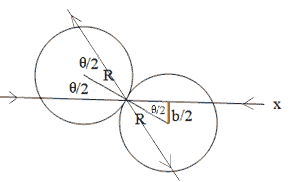
The in the CM
frame the initial velocity of disk A is 5 m/s i and the initial
velocity of disk B is -5 m/s i.
After the collision disk A has
velocity components vxA = -5 m/s cosθ, vyA = 5 m/s
sinθ, and disk B has velocity components vxB = 5 m/s cosθ, vyB
= -5 m/s sinθ.
In the lab frame vA = 5 m/s (1 - cosθ)
i
+ 5 m/s sinθ j,
and vB = 5 m/s (1 + cosθ)
i - 5
m/s sinθ j.
vA2 = 25 m2/s2 =
25 m2/s2 [(1 - cosθ)2 + sin2θ].
2 - 2cosθ = 1, θ = 60o.
Impact parameter b: b = 2R sin30o
= R.
Problem:
Consider the perfectly elastic scattering of a hard sphere of mass m and
initial velocity v0 against a stationary hard sphere of mass M. The
sum of the radii of the two spheres is D.
(a) Compute the energy lost by the small mass in the collision in the lab frame
as a function of the scattering angle θ in the center of mass frame.
(b) Compute the probability P(θ)dθ of scattering through an angle θ in the
center of mass frame, assuming that the particles m in the incident beam are
uniformly distributed across a cross section of the beam. Find the differential
scattering cross section σ(θ), and show that your expression integrates to the
known total hard sphere cross section πD2.
(c) Use the results of parts (a) and (b) to compute the average energy loss per
collision. For what value of m/M does the average energy loss maximize?
Solution:
- Concepts:
Elastic scattering, energy and momentum conservation,
frame transformations
- Reasoning:
In the elastic collision kinetic energy and momentum are conserved. A frame
transformation is necessary because the energy lost by the small mass in the
lab frame is given in terms of the scattering angle in the CM frame.
- Details of the calculation:
(a) The CM frame moves with respect to the laboratory frame with speed V.
Before the collisions: m(v0 - V) = MV. Therefore: V = mv0/((m
+ M).
In the CM frame m has speed (v0 - V) = Mv0/(m + M) =
v' before and after the collision.
In the lab frame the speed of m after the collision is v.

v2 = v'2 + V2 + 2v'Vcosθ = v02(m2
+ M2 + 2mMcosθ)/(m + M)2
= v02(1 - 2mM(1 - cosθ)/(m + M)2).
(v2 - v02)/v02 = ∆E/E
= -2mM(1 - cosθ)/(m + M)2).
∆E = -v02m2M(1 - cosθ)/(m + M)2)
is the energy lost by the small mass in the collision in the lab frame as a
function of the scattering angle θ in the center of mass frame.
(b) Let b be the impact parameter.
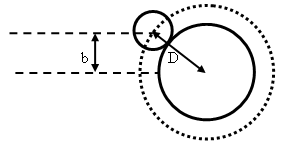
For particles which collide, P(b)db = 2πbdb/(πD2) is the
probability of a collision with impact parameter between b and b + db.

θ = π - 2α. b = Dsinα.
The relationship between the impact parameter and the scattering angle is
b = Dsin(π/2 - θ/2) = Dcos(θ/2), db/dθ =
-(D/2)sin(θ/2).
P(θ)dθ = P(b)|db/dθ|dθ = 2b|db/dθ|dθ/D2 = cos(θ/2)sin(θ/2)dθ
= ½sinθdθ.
∫0πP(θ)dθ = 1.
σ(θ) =|(b/sinθ)(db/dθ)| = ½D2cos(θ/2)sin(θ/2)/sinθ.
σ(θ) 2π sinθ dθ = πD2cos(θ/2)sin(θ/2)dθ = πD2 P(θ)dθ.
∫0π σ(θ) 2π sinθ dθ = πD2.
(c) average energy loss = ∫0π∆E(θ) P(θ)dθ
= (½v02m2M/(m + M)2) ∫0π(1
- cosθ)sinθ dθ = v02m2M/(m + M)2
= v02m(m/M)/(m/M + 1)2.
d(x/(x +1)2)/dx = 0 for x = 1.
The average energy loss maximizes for m/M = 1. The average energy loss then
equals ½ of the initial kinetic energy.
Scattering by a 1/rn potential
Problem:
A particle of mass m moves under a central repulsive force F(r) = km/r3.
At its distance of closest approach r0 it has speed v0.
(a) Find the orbital equation r(θ) for the particle motion, evaluating
constants in terms of r0 and v0.
(b) Find the impact parameter and the total angular deflection, assuming the
particle approaches from large r.
(c) Sketch the particle trajectory, indicating the impact parameter and total
deflection calculated in part (b).
Solution:
- Concepts:
Motion in a central potential, F = f(r)(r/r),
f(r) = -dU/dr, impact parameter b (M = mbvinf)
For motion under the influence of a central force E and M are
conserved.
M = mr2φ, E = ½m(dr/dt)2 + Ueff(r), Ueff(r)
= U(r) + M2/(2mr2).
The equation that relates the orbit to the force is
(M2u2/m)(d2u/dφ2 + u) = -f(u),
where u = 1/r.
- Reasoning:
We are given the force and are asked to find the equation of the orbit. We
are then asked to find a relationship between the impact parameter and the
total deflection.
- Details of the calculation:
(a) f(u) = kmu3, d2u/dφ2 + u = -(km2/M2)u,
d2u/dφ2 + (1 + km2/M2)u = 0,
u = A sin(Bφ + C).
B2 = (1 + km2/M2), M = mbvinf =
mr0v0, B2 = (1 + k/(r0v0)2).
Let u = 0 at φ = 0, then C = 0.
At the distance of closest approach φ = φ0, r = r0 = rmin,
u = umax.
1/r0 = A sin(Bφ0) = A sin(π/2), Bφ0 =
π/2, A = 1/r0,
1/r = (1/r0)sin((1 + k/(r0v0)2)½φ)
(b) Bφ0 = π/2, φ0 = π/(2B). We need φ0
in terms of the impact parameter b.
From energy conservation we have E = ½mvinf2 =
½mv02 + km/2r02,
vinf2 = v02 + k/r02.
b = r0v0/vinf, b2 = (r0v0)2/(v02
+ k/r02) = r02/B2.
b = r0/B is the impact parameter.
φ0 = πb/(2r0). θ = π - 2φ0 is the
deflection angle.
(c) For example, pick b = r0/2, then φ0 = π/4, θ =
π/2.
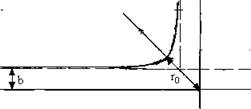
Problem:
A fixed force center scatters a particle of mass m and initial velocity
u0
according to the force law f(r) = k/r3. Determine the
differential scattering cross section.
Solution:
- Concepts:
A particle moving in a central potential
U = U(r), F
= f(r)(r/r), f(r) = (-∂U/∂r). U = k/(2r2). E > 0
for scattering.
- Reasoning:
We are asked to find the differential scattering cross
section for a particle being scattered by a central force.
- Details of the calculation:
fr
= -∂U/∂r = k/r3.
σ(θ) = |(b/sinθ)(db/dθ)| θ = π - 2φ0 if k > 0.
We need to find
θ as a function of b.
U = k/(2r2), U(u) = ku2/2,
u = 1/r.
φ0 = ∫0u_max bdu/(1 - b2u2
- ku2/(2E))½
for motion in a central potential.
umax = (E/(b2E +
k/2))½.
Let k > 0, repulsive potential:
φ0 = b(b2 + k/(2E))-½∫01 du'/(1
- u'2)½, u' = (b2 + ku/(2E))½.
φ0 = b(b2 + k/(2E))-½sin-1(1)
= (bπ/2)/(b2 + k/(2E))½
since ∫dx/(a2
- x2)½ = sin-1(x/a).
θ = π - πb/(b2 + k/(2E))½, (π - θ)2 =
(πb)2/(b2 + k/(2E)),
b2 = [k/(2E)](π -
θ)2/[θ(2π - θ)].
db2/dθ = 2bdb/dθ = -(k/E)π2(π
- θ)/[θ2(2π - θ)2].
σ(θ) = (k/(2E))π2(π
- θ)/[θ2(2π - θ)2sinθ].
Let k < 0, attractive
potential:
If b2E < |k/2| we find no solution for umax,
there is no turning point, the particle spirals into the origin. Its
angular velocity increases beyond any limit, such that mr2dφ/dt =
M stays constant.
If b2E > |k/2| we have φ0 =
(bπ/2)/(b2 + (k/(2E)))½ > π/2.
φ0 may
be much larger than 2π, the particle may turn around the force center
several times.
Problem:
Two particles of mass m are moving in the x-y plane. The inter-particle
potential energy is U(r1 -
r2) = U0/|r1
- r2|2 with U0 > 0. The initial
conditions are
r1(t = 0) = (-∞, -y0),
r2(t
= 0) = (∞, y0), and p1(t = 0) = (p0, 0),
p2(t = 0) = (-p0, 0),
with p0 > 0.
What is the distance of closest approach of the two particles?
Solution:
- Concepts:
Motion in a central potential.
- Reasoning:
The problem of the relative motion of two interacting
masses m1 and m2 can be solved by solving for the
motion of one fictitious particle of reduced mass μ in a central field.
- Details of the calculation:
For motion in a central field energy E
and angular momentum M are conserved.
E = p02/2μ =
p02/m, M = 2y0p0.
At the
distance of closest approach: E = pc2/m + U0/rc2,
M = rcpc. Here rc = |r1
- r2|c.
Then pc = M/rc,
E = M2/(mrc2) + U0/rc2
= 4y02p02/(mrc2)
+ U0/rc2 = p02/m.
rc2 = 4y02 + mU0/p02.
The distance of closest approach is rc = (4y02
+ mU0/p02)1/2.
Problem:
A point like comet of mass m approaches a sun with mass M and Radius R with
speed v∞ > 0. What is the total cross section for the comet to
crash on the sun?
Solution:
- Concepts:
Motion in a central potential.
Reasoning:
The comet
has a hyperbolic orbit. Energy E and angular momentum L are conserved, the
motion is in a plane.
L = mbv∞ = mrcvc,
where rc is the distance of closest approach, and vc
is the speed at rc.
The potential energy of the comet is U(r)
= -GMm/r. If rc < R, the comet will crash onto the sun.
We
find the relationship between rc and b, and find the largest
impact parameter bmax for which rc < R.
The cross
section for crashing onto the sun is σ = πbmax2.
- Details of the calculation:
For motion in a central field energy E
and angular momentum L are conserved.
E = ½mv∞2 =
½mvc2 - GMm/rc. vc2
= v∞2 + 2GM/rc.
L = mbv∞ = mrcvc,
v∞ = rcvc/b.
b = rcvc/v∞
= rc(1 + 2GM/(rcv∞2))½.
bmax = R(1 + 2GM/(Rv∞2))½.
σ
= πR2(1 + 2GM/(Rv∞2))½.
Problem:
In frame B particles with speed vB << c are scattered uniformly in
all directions. Frame B moves with velocity v0k (v0
<< c) with respect to frame A.
(a) If the scattering angle of a particle in frame B is θB,
what is the corresponding scattering angle θA in frame A, and what is
the speed of the particle vA?
(b) Given that dσ/dΩB = K = constant, derive an
expression for dσ/dΩA in terms of v0, vB,
vA, and θA.
(c) Show that when v0 > vB, there is a maximum angle
θA_max, which is given by sinθA_max = vB/v0.
(d) What happens to dσ/dΩA near θA_max?
Solution:
- Concepts:
Frame transformations
- Reasoning:
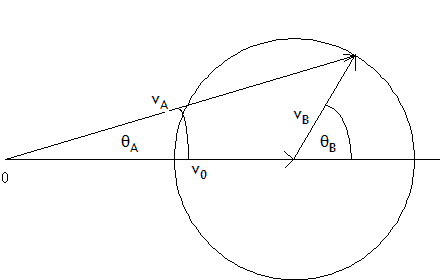
Using the figure and trigonometry, we can find vA
and θA
in terms of v0, vB, and θB.
- Details of the calculation:
(a) vA = v0 + vB.
vAcosθA = vBcosθB + v0, vAsinθA
= vBsinθB, or tanθA = sinθB/(cosθB + γ).
Here γ = v0/vB.
θA = tan-1(sinθB/(cosθB + γ)).
vA2
= v02 + v'B2 +2v0vBcosθB.
(b) σ(θA,φA)dΩA = σ(θB,φB)dΩ.
σ(θA,φA) sinθA dθA = σ(θB,φB) sinθB dθB.
(The angle φ is the same in the CM and laboratory frame.)
We can therefore write
σ(θA,φA) = σ(θB,φB) sinθB dθB/(sinθA dθA)
= σ(θB,φB) dcosθB/dcosθA.
We have tanθA = sinθB/(cosθB + γ).
Somehow we have to use this to evaluate dcosθB/dcosθA.
Use tanθA = (1/cos2θA - 1)½
= sinθB/(cosθB + γ).
Let x = cosθB
and y = cosθA.
tanθA = (1/y2 - 1)½ = (1 - y2)½/y
= (1 - x2)½/(x + γ).
y2 = (x + γ)2/(1 + 2xγ + γ2).
dy/dx = (1 + γx)/1 + γ2 + 2γx)3/2.
This then yields
σ(θA,φA) = σ(θB,φB) (1 + γ2 + 2γcosθB)3/2/|1
+ γcosθB|.
(c) When v0 > vB, γ = v0/vB
> 1.
d(tanθA)/dθB = (cos2θB
+ γcosθB + sin2θB)/(cosθB + γ)2
= (1 + γcosθB)/(cosθB + γ)2
= 0 --> cosθB = -1/γ.
tanθA has a maximum when cosθB = -1/γ.
tanθA-max = (1 - 1/γ2)½/(γ - 1/γ) =
(1/γ)/(1 - 1/γ2)½.
1 + cot2θA-max = 1/sin2θA-max
= γ2. sinθA-max = 1/γ.
We can also just work from the figure. θA has its maximum value
when vA is tangential to the circle. Then the angle between vA
and vB is a right angle, and sinθA-max =
vB/v0 = 1/γ.
(d) |1 + γcosθB| --> 0, therefore
σ(θA,φA) --> ∞.








